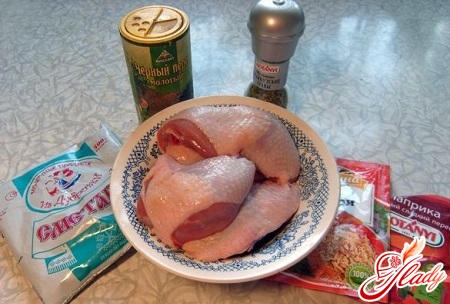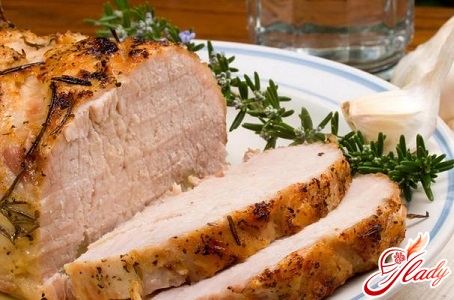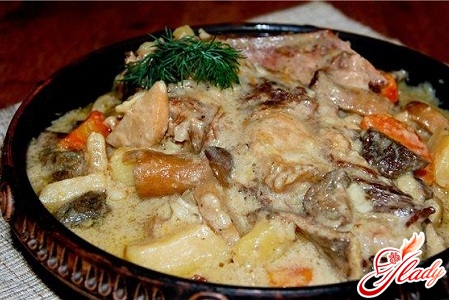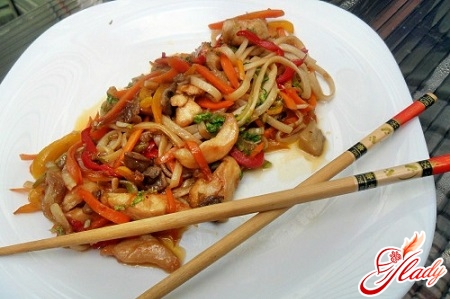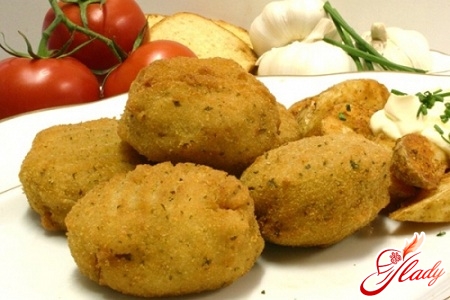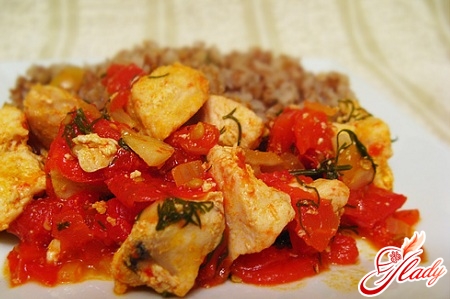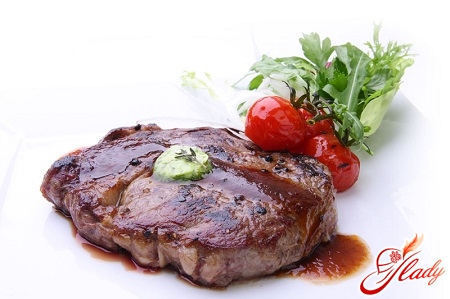
More F.Engels once said that man could not become man without meat. Vegetarians, forgive us, but it is hard to argue with this. Meat is a supplier of essential nutrients necessary for the normal functioning of the human body, primarily complete protein, richer in essential amino acids than plant proteins, which, in addition, is easier to digest and promotes more complete digestion of plant proteins. Meat contains minerals and vitamins that we need so much. For example, vitamin B, the lack of which leads to serious diseases, is found only in meat and other animal products. Today we will talk not just about meat, but about ideal meat, about how to cook a beef steak. Steak is one of the oldest dishes, the recipe for which was suggested by nature itself. We will not go into the history of the origin of steak, especially since it is full of legends, from sacrificial rituals in Ancient Rome to the inclusion of steak in American culture. One thing remains the indisputable truth - after thousands of years, steak has turned into a kind of cult, from the choice of meat to its serving at the table. Steak is not an everyday food. The recipe for cooking steak requires special conditions, and, no less importantly, a special atmosphere. Steak is often confused with an ordinary chop or French meat, mistakenly believing that this is an ordinary piece of meat fried over an open fire or in a frying pan. What could be easier - take a piece of meat and fry a beef steak. But only at first glance does cooking this dish seem like a simple task. The recipe is really not that complicated. But not everything is so simple. We will tell you how to properly cook a steak at home, armed with several rules. What is needed to get the perfect beef steak - tasty, aromatic and juicy?
So, first thing is - the right meat
The favorite steak is beef steak,Ideally, it is made from the meat of young bulls. The classic recipe involves using meat from Hereford or Agnus bulls. However, the taste of the future steak depends not only or not so much on the breed as on the method of fattening the animals - grass or grain. Since grain is rich in protein, this feed promotes the formation of thin fat layers in muscle fibers. Such meat is also called marbled. It is more tender, although less flavorful than the meat of animals raised on grass fattening. Steak in translation from English sounds like "tenderloin", that is, it is a fairly thick piece of meat (a portioned piece should be at least 3 cm thick), cut strictly in the transverse direction from those parts of the animal's carcass, the muscles of which were not involved in motor activity. This meat is considered the most tender. However, there are few such non-coarsened parts in the animal's carcass (no more than 7-10%), and that is why beef steak is considered a delicacy. For example, it is absolutely impossible to cook a decent steak from the breast or leg meat, no matter how magical the recipe. The most suitable meat for beef steak is the back and fillet. Choose those parts of the carcass that do not have tendons and powerful muscles. Depending on what part of the carcass the piece was taken from, in modern steak culture there are several main types of beef steak.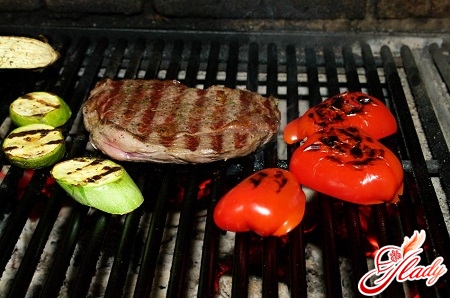
What are the types of steak?
Rib steak is a steak based onis a piece of meat from the subscapular part of the carcass, which has many fat veins, which contribute in the best way to the juiciness of the dish. Club steak - a piece of meat for such a steak is cut from the thick edge of the longest back muscle, has a small rib bone. T-bone steak (or steak on a T-shaped bone) - a part of the carcass is used in the area of the thin edge of the longest back muscle and the thin edge of the tenderloin, on the border between the back and lumbar parts. A piece cut in this way consists of two types of steak meat at the same time - filet mignon on one side and a T-shaped bone on the other. Porterhouse steak and striploin steak - steaks from the lumbar part of the back, but in the first case a piece of meat is taken from the thick edge of the tenderloin, and in the second - from the head of the tenderloin. Roundrumb steak - this steak is made from the top cut of the hip part of the carcass. Filet mignon - this steak is not for those who like rare meat, since the most tender and lean meat is used for its preparation - a thin transverse cut from the central part of the fillet. Chateaubriand - is prepared from the thick edge of the central part of the beef tenderloin. In essence, this is a large filet mignon, which, when ready, is laid out on a plate lengthwise, after which it is cut into portions. Tournedos - small pieces from the thin edge of the central part of the tenderloin are used, usually for making medallions. Skirt steak - this steak is prepared from a piece of meat from the flank (the steak is not the most tender, but very tasty).
Basic rules for choosing meat
When choosing meat, remember that it depends on its colorIt should be bright red, from red to dark red, but not pink or burgundy. The meat for beef steak should be mature, but not old and not young. The recipe for success is not to use fresh beef. Freshly cut slices of meat from the carcass will have to rest, keeping them in the refrigerator for a couple of days at a temperature of +2°C until the blood flows out of them. During this time, the enzymes in the meat will gradually loosen the muscle tissue, and the beef will become softer, more tender and juicy. When choosing meat, pay special attention to its elasticity, the meat should be quite dense in composition. To determine whether the steak will be soft, press your finger on the raw meat: if a deep dimple forms when you insert your finger, which smoothly levels out after releasing, taking its original position, then the meat is good. Not too fresh meat resembles a sponge, when you press on it with your finger, the dimple does not straighten out.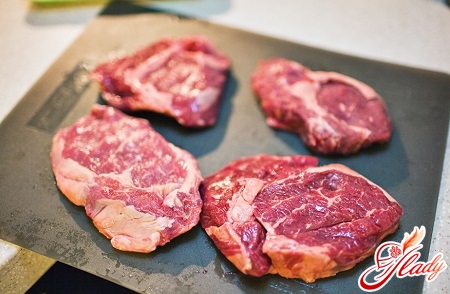
Chilled or frozen?
Experienced chefs claim that with the rightWhen defrosting, it is quite difficult to distinguish by taste what kind of meat was taken to prepare a steak - chilled or frozen. It is enough to defrost the meat correctly, observing some basic rules: do not defrost meat under any circumstances either at room temperature, or in a microwave (even in defrost mode), or under a stream of cold (and especially hot) water. With such an emergency defrosting, crystals of frozen liquid will simply tear apart the delicate fibers of the meat. Defrosting meat is a slow and natural process that should take place at a temperature close to 0 ° C, if possible - in the main compartment of the refrigerator. And even if it takes you quite a long time, this is the best way to preserve the meat's nutritional value.
Let's Get Ready
The meat must be thoroughly cleaned, decisivelycutting off all the films and upper tendons, then wash it, preferably with a brush, after which it should be put to dry in a colander or on a cloth for about 10 minutes. The recipe for proper cutting is simple. Slices of meat for beef steak should be cut strictly across the grain. This cutting of meat will allow the heat to pass evenly through the fibers during cooking, quickly and evenly heating the meat to the required temperature. The pieces should be 3 to 5 cm thick. For cooking steak in a frying pan, 3 cm will be enough, and when cooking on coals, the thickness of the piece can reach 5 cm. Remember that meat for steak is never beaten, since this way it loses not only its structure, but also all the juices. In addition to the meat itself, to cook a beef steak you need to stock up on any vegetable oil (preferably olive oil) and a set of spices or herbs. Spices will allow you to enjoy the true taste of meat. In order for the meat to be airy-tender and brightly juicy, it should be marinated beforehand. There are many ways to marinate meat for a beef steak. This process lasts about 10-12 hours. The marinating dish should be porcelain, glass or ceramic, always with a tight-fitting lid. The traditional marinade recipe is a mixture of olive oil, wine vinegar (or lemon juice), soy sauce, salt and seasonings. Important advice: when preparing the marinade, use a small amount of salt, so the meat will not lose its juiciness and will be more delicious. It is better to add salt to the steak during frying or even at the very end.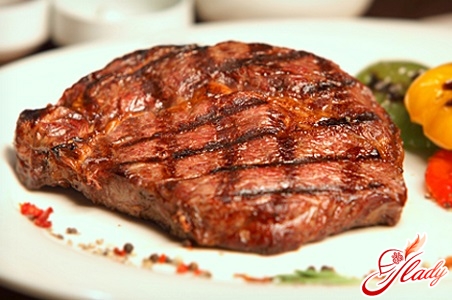
Choose the right dishes
The second rule for getting the perfect steakbeef, in addition to the choice of meat, is the choice of cookware. For cooking, you will need a frying pan. Ideally, this should be a special grill pan. However, an ordinary "grandmother's" cast-iron frying pan, which is probably in every kitchen, will do just fine. Electric cookware is not quite suitable for cooking steak, since in this case it will be more difficult for you to control the required temperature. The frying pan for cooking steak should be well heated. Oil is poured onto already heated cookware. Remember that the frying pan has heated up to the required temperature if, when you put the steak on it, you hear a characteristic sizzling sound. When it hits the hot surface of the frying pan, a ruddy crust forms on the meat, which prevents juice from flowing out and thanks to which the steak remains juicy. If the piece of meat is thick enough, you can use special tongs to fix the piece perpendicular to the frying pan, thus sealing the edges of the steak. To get the perfect steak, do not fry more than one piece at a time in one pan. As you add meat, the pan will cool down, the crust on the surface of the meat will not form for a long time, the meat, accordingly, will lose juices, and the steak will be dry, tough and tasteless. During cooking, you need to watch the oil carefully. If it starts to foam, you need to immediately increase the heat to avoid boiling the juice released by the meat, which must certainly remain inside the steak, behind the crispy crust. Using one recipe, you can cook at least three different beef steaks, differing in the degree of juiciness. Depending on the length of time the meat is kept in the pan, the steaks can have different degrees of doneness.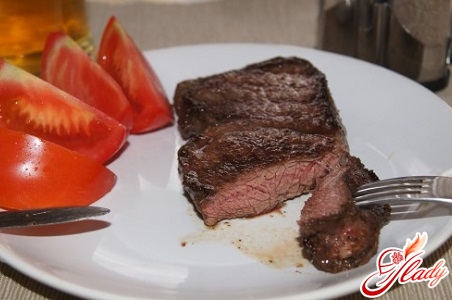
There are three basic types of roasting
The degree of Rare, or steak with blood, is obtainedwith a roasting time of 4 minutes, two on each side. The finished steak has an internal temperature of 45°C to 50°C. In this case, only a crust will appear on the meat. The Medium degree of roasting is typical for medium-done meat with pinkish meat juice, the roasting time is about 8-10 minutes. The internal temperature of the steak is from 55°C to 60°C. At the Medium degree, ideal tenderness and juiciness of meat is achieved. The Medium Well degree of roasting is achieved by frying the steak for 8 minutes in a frying pan and 4 minutes in the oven, preheated to the maximum temperature. The meat is well-done, with an internal temperature of 65°C to 70°C. The readiness of the steak is easy to check by pressing it with your finger. A rare steak will be soft, well-done - firm, and a medium steak is something in between. And the last rule, which applies equally to all meat dishes - after removing the meat from the heat, let it "rest", mature for about 5-10 minutes, so that all the juices released during frying can be evenly distributed throughout the piece. If you start cutting the meat right away, the juice will flow out and the steak will be dry. After the finished meat has "rested", it can be served to the table on a warm plate. Garlic bread or vegetables in any form, but in small quantities, are perfect as a side dish for steak. Remember that steak is the king of your table, do not distract attention from it with a side dish. And to top off creating the appropriate atmosphere - stock up on a bottle of dry red wine. Now you know the recipe for the perfect dish. A perfect evening awaits you!




